Oh Mexico!
Don Julio…
The trip began with a snow storm in NY where we narrowly escaped, these memories were quickly forgotten once we arrived in sunny Guadalajara Mexico and checked ourselves into 4 star hotel named Quinta Real. Where, for $150 a night, you get to sleep in a mini suite, receive great service from friendly staff and dine on wonderful Mexican food.
The following morning sweet and wise Grisel (the head of PR and Marketing for Don Julio and rightfully so) picked us up from the hotel to take on our tequila immersion.
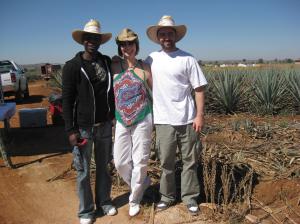
First on the agenda, the agave fields, upon arrival we were greeted by a Jimador, who gave us an insightful explanation on how the identify which agaves were ripe , how to trim off the Penca’s leaves so only the white of pina (the heart of plant) is left. To our delight they allowed us to take a stab at trimming our own agave.
Don Julio has very special belief about how the agave plants should be treated. This is one of my favorite stories about this tequila. His philosophy on how agave should be treated is similar to those of how most good parents feel about raising their children. Being a mother of a 4 yr old, I could really appreciate it. First, they should be given plenty of space to grow, 2nd plenty of sunlight (to help make them sweeter), 3rd they should not be rushed to grow up before their time (some distillers trim the agave leaves to speed up the growth process) and lastly they should not be kicked out of the earth (aka their home), until they are fully mature. Don Julio is now in his mid 80’s and though he does not move around quite as well as he used to, I heard he still visits his agaves 2-3 times a week.
After attempting to master the art of trimming the agave, we were treated to a traditional Jimador lunch, now they typically enjoy this after trimming over 100 agaves, between the 3 of us I think we finished 2 agaves completely. What that says about us I don’t know, but I am sure the Jimadors found it entertaining. Now that we were sufficiently stuffed with delicious tortillas we headed to see where the magic happened.
(On side note and just for the record, Remi (aka Bush Boy) showed some serious skills in the art of agave trimming, Tim still needs a little work and me, well lets just say I should stick to speaking about it and not making it.)
We arrive at La Palamo the Don Julio Distillery where the locked gates carefully guarded by security are opened for our arrival. (Don Julio is not currently opened for the public to visit).
The first step in the process is a quality check for the pinas brought in from the field:
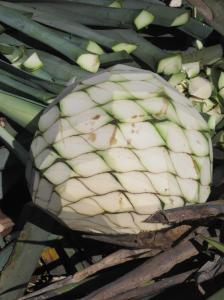
We were led to a large open space where the agaves from the fields are unloaded on to the ground. Grisel explains how numbers are placed at random into the lot of agaves. Those chosen are then distilled into their own individual batch of tequila; from there they are tested for sugar content, taste etc.
If one agave does not meet their criteria the whole lot is rejected.
Once approved the pinas are cut into equal parts so they may all roast at the same rate. During the process of cutting the pina, the workers take an extra step to make sure to remove the bitter parts (male and female organ) located inside the plant because it can impart a harsh flavor to the tequila. ( many tequila companies forego this extra step and throw the whole pina in) The agave are slowly cooked for 72 hours in a masonry oven.

After they are cooked they are sent to the mill to be shredded and then pressed to squeeze the remaining honey water out of the fibers. During the pressing process, water is also run over the fibers to help extract any remaining honey water.
Next we walked along the catwalk to stick our heads into the fermentation tanks. The honey water is collected and dispersed into the tanks; here a yeast strain created from the agave plant is added to start the fermentation process. Don Julio fermentation process takes up to 36hrs, next step distillation.
Down the stairs we enter an area where a row of medium size copper pots stills are located. At the end of the row is still # 6, a much smaller still where 1942 and Real are created. The others Blanco, Reposado and Anejo are distilled 2x in copper pot stills.
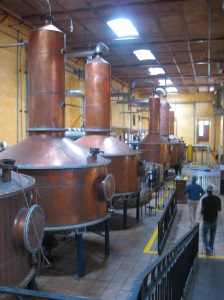
Aging: After distillation the tequila is either bottled immediately for Blanco, or aged up to 8mos for the Reposado, 18mos for the Anejo. All aging occurs in temperature controlled warehouses in American Bourbon barrels.
From there, after being blown away by the intensive process that we just witnessed, Grisel took us to a private viewing room where we enjoy a movie describing the incredible story of Mr. Don Julio Gonzalez. There we were asked to sign barrels of 1942 this right of passage guarantees future invitations back to the Distillery. (sign me up please!)
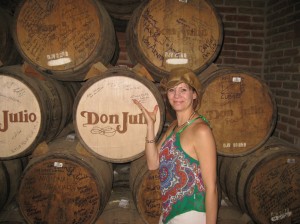
Last but not least, Grisel leads us to their new beautiful designed bar/tasting room. (Nice work folks of Don Julio, this is the one part that I felt was missing to complete the experience the last time I was here) Grisel treated us to tasting of all 5 marques where Tim Cooper decides his new love is no longer Don Julio 1942 (though he will never turn it down) but the Anejo. The Bushman is still dedicated to 1942 and for myself, well I love them all but Real is still my number one choice. What can I say? I have expensive taste!
The day concluded with lunch at a beautiful restaurant where we had the honor of Enrique the Master Distiller dining with us. It doesn’t get much better then this.

*Side note: Enrique showed us a new drink or a least a combination of ingredients that I would never think would mix. Don Julio Blanco, 3 lime zest squeezed over the ice and tonic. The D&T it was brilliant. Clean refreshing and so simple.
Needlessly to say we were blown a way by the whole experience. To have intimate tour of the distillery is a rare treat and I am truly honored to have experience this with Remi and Tim. True Gentleman!
Day Two:
A visit to Jose Cuervo: Upon arriving we were led straight to the agave fields, where again we had a chance to master the skill of trimming the agave plant. Remi (aka bushman) was definitely a master and may have a new career ( hmm, an African Jimador, that would definitely be different) I got to give some credit to my boy Tim. I am not sure if he was practicing in his room but he was coming in at a very close 2nd. As for me, I was just as bad as the day before. What can I say, manual labor is not for me.
Next stop the Jose Cuervo Distillery. Wow what a different experience, this place is much larger and very scenic. Upon entering you are greeted with a frozen margarita which wasn’t bad but when you are cocktail snobs like ourselves it takes a lot to impress us. We drink them down all the same.
Feeling like pro’s after our intensive tequila training the day before, we cruise through the tour without many questions but learn some new stuff all the same. For instance JC doesn’t cut away the male and female organ or all of the green parts before steaming the agaves. They like their tequila to have little bit of extra kick which tends to be the typically lowland style. The green parts and organs are only removed when making Platino and Reserva.
The agaves here are cooked in autoclave and takes about 36hrs to process, unless they are making Platino/Reserva which takes up to 72hrs. Just like the other distillery the cooked agave is milled, fermented and double distilled. Being a much bigger company the # of stills is 10x the amount and takes many more people to manage.
Platino and Reserva go through a slightly different process. Instead of using water during the pressing process, they use the honey from the very first pressing to ferment. This gives the tequila its full body taste.
From there the tequila is either rested in barrels to age or bottled.
Our tour concluded with a special treat, we were allowed to visit the cellar where they stored the barrels of Reserva De Famila. (Being one of my favorite spirits in the world I was truly excited.) Our guide gave us taste right out of the barrel, at 125 proof this spirit was perfect.

Night Life in Mexico:
Sadly this was the end of our tour and night of debauchery lay ahead.
By now we had grown tired of eating heavy Mexican food, so we decided to enjoy an evening of light nibbles and cocktails instead. First stop La Tequila, a second floor modern Mexican bistro where music videos from the 80’s to our delight played endlessly at the bar.
*Side note: Ok, so I want you all to picture this… three New York bartenders sitting at the bar, sampling Tamarind Margaritas and endless neat samplings of other tequilas (not too unusual yet…) and watching one 80’s video after another with glee (I am talking huge smiles with mindless gazes). I swear we could have stayed there all night if the spell was not broken. I still don’t think Remi, has forgiving Tim and I for making him leave in the middle of the Ricky Martin video.
Next stop: Wall Street , now why this place is called Wall Street is still a mystery to us. The place was decked in surf boards and palm trees- Tikki bar anyone?? Anyway it looks like a live band it about to go on, so we dutifully get a table an order a bottle of Don Julio Reposado and some grapefruit soda. Total cost $80- beat that. As for the band what I can say except Tuba player (yes a full on tuba) and the lead singer played, hold on to your seats an accordion. Players is doesn’t get much better then this, hence why we left.
So feeling a bit frisky, we decided to head to our favorite salsa place (el Diablo) that we had found the night before. Tequila, cervazas and dancing perfect night and to top it we have intrigued some of the natives who have now adopted us into their group and drag us to a piano/karoke bar. Nice people but we were ready to go home.
Day Three:
The next day still licking our wounds, we sadly met for breakfast one last time. The boys head off for their flights and I am off to visit the distillery of El Tesoro. Upon arriving, the affects of last night’s outing had taken a hold of my head but thankfully the gods were smiling on me. Another woman visiting the distillery happened to have a cure (thank you, thank you, thank you) and our ever so gracious host Philippe Camarena who was good enough to source some liquid to wash it down. Needless to say, 1 hour later I was right as rain (well sort of )
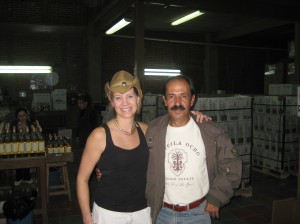
This day was truly special; Philippe the distiller of Ocho and the brother of Carlos the distiller of El Tesoro was kind enough to spend the afternoon with us. He took us step by step through the different processes for each of tequilas that are made at this site. These would include: Trago, El Tesoro, Ocho, Excelia and Tapatio. The distillery itself it very small and each tequila is completely unique, so only one tequila can be made on one given day. Personally was hoping to see how El Tesoro was made but alas that was not to be. El Tesoro is one tequila who does everything just a little bit different or should I say the old school way. The roasted agaves are milled using a traditional Tahona,
why you may ask well by using the Tahona they are able to get a 100% of the sugar out of the agave plant. Now the one thing that blew my mind was the fact that they only had one, strange don’t you think? Once the juices are obtain they must go through the fermentation process and this were El Tesoro truly stands out. Why you may ask well they not only add the agave nectar (honey water) into the wood open face fermentation tanks but they also add the fibers. To top it off a man must be present inside the tank to hand mill the tank and the fibers.
Once fermented for the proper amount of time, these fibers are then removed by hand before the fermented juice is sent to the two small copper pot stills for distillation, where it is distilled to proof, meaning no water is added.
After this trip back in time, Philippe whisked us off to his new environmental friendly and energy efficient distillery “El Pandillo”, where”Ocho” the only vintage tequila currently on the market will be made. Now to be honest, you would have to be an engineer to take in everything that Philippe threw at us ,but from what I gathered, this distillery is going revolutionize the entire industry, for all spirits. To be continued….
My trip concluded with a trip to the bottling plant, which used to be his fathers house and ended with drink at Philipe’s home where I had a chance to taste a rare bottle of green El Tesoro. All I can say about that is that it involves an iron pole and not so careful distillery worker but it was still delicious all the same.
Until my next journey…
I hope you enjoyed my stories and if you have any insight to share please email me at Elayne@dukeontherocks.com


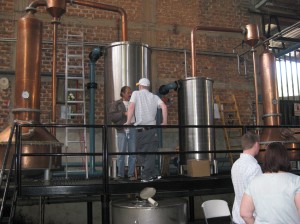
Hey, how funny to stumble across this – I’m the guy you met at La Altena (who’s wife had the cure for your previous night – I see the back of my head in your picture above 🙂 ).
I hope you still have some of your Ocho – we somehow managed to drink one whole bottle of ours the weekend after we got back home! Good thing we have a spare…
I found this page doing a search for Trago – we just had some in Chicago and it was unreal! Definitely give it a try if you haven’t already.
I forgot to take a picture of the Tahona wheel so I hope you don’t mind me taking yours.
Cheers
Andy,
Hi, great to hear from you. What a funny day that was, thank god i left when i did, my bed never looked so good.
As for the Ocho i still have mine, i have been waiting to have a tequila tasting with my friends.
As for the Trago I got to say i was not a fan when i tasted it a year ago, but who knows maybe it has gotten better.
I will give it a try again and let you know. One of my favorites is Don Julio 1942, it is expensive but so worth it.